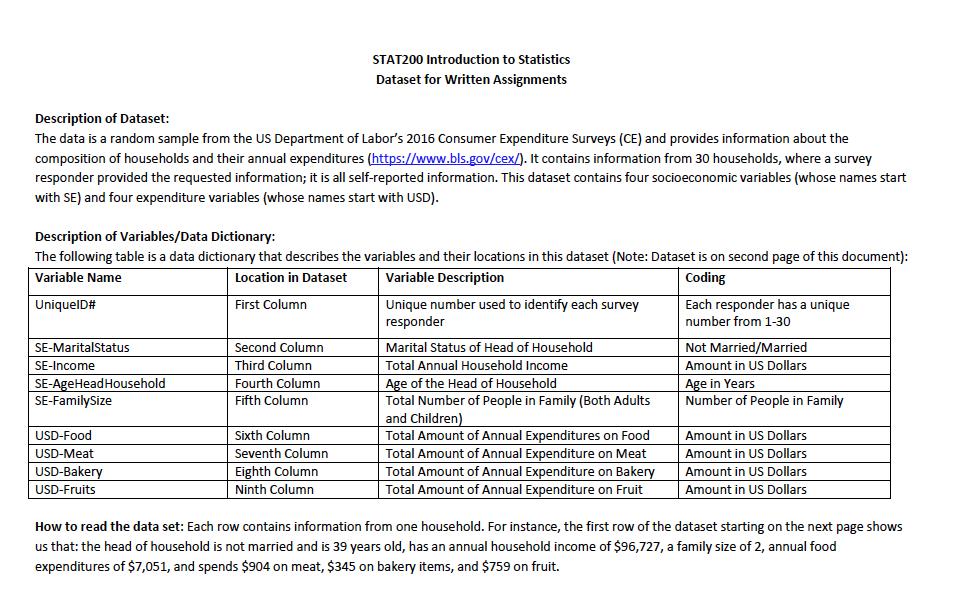Question
Inferential Statistics Data Analysis Plan and Computation Introduction: Variables Selected: Table 1: Variables Selected for Analysis Variable Name in the Data Set Variable Type Description
Inferential Statistics Data Analysis Plan and Computation
Introduction:
Variables Selected:
Table 1: Variables Selected for Analysis
Variable Name in the Data Set | Variable Type | Description | Qualitative or Quantitative |
Variable 1: Marital Status | Socioeconomic | ||
Variable 2: Food | Expenditure | ||
Variable 3: Fruit | Expenditure |
Data Analysis:
1. Confidence Interval Analysis: For one expenditure variable, select and run the appropriate method for estimating a parameter, based on a statistic (i.e., confidence interval method) and complete the following table (Note: Format follows Kozak outline):
Table 2: Confidence Interval Information and Results
Name of Variable: |
State the Random Variable and Parameter in Words: |
Confidence interval method including confidence level and rationale for using it: |
State and check the assumptions for confidence interval: |
Method Used to Analyze Data: |
Find the sample statistic and the confidence interval: |
Statistical Interpretation: |
2. Hypothesis Testing: Using the second expenditure variable (with socioeconomic variable as the grouping variable for making two groups), select and run the appropriate method for making decisions about two parameters relative to observed statistics (i.e., two sample hypothesis testing method) and complete the following table (Note: Format follows Kozak outline):
Table 3: Two Sample Hypothesis Test Analysis
Research Question: |
Two Sample Hypothesis Test that Will Be Used and Rationale for Using It: |
State the Random Variable and Parameters in Words: |
State Null and Alternative Hypotheses and Level of Significance: |
Method Used to Analyze Data: |
Find the sample statistic, test statistic, and p-value: |
Conclusion Regarding Whether or Not to Reject the Null Hypothesis: |
Part B: Results Write Up
Confidence Interval Analysis:
Two Sample Hypothesis Test Analysis:
Discussion:

STAT200 Introduction to Statistics Dataset for Written Assignments Description of Dataset: The data is a random sample from the US Department of Labor's 2016 Consumer Expenditure Surveys (CE) and provides information about the composition of households and their annual expenditures (https://www.bls.gov/cex/). It contains information from 30 households, where a survey responder provided the requested information; it is all self-reported information. This dataset contains four socioeconomic variables (whose names start with SE) and four expenditure variables (whose names start with USD). Description of Variables/Data Dictionary: The following table is a data dictionary that describes the variables and their locations in this dataset (Note: Dataset is on second page of this document): Variable Name Location in Dataset Variable Description Coding UniquelD# First Column Each responder has a unique Unique number used to identify each survey responder number from 1-30 SE-MaritalStatus Second Column Marital Status of Head of Household Not Married/Married SE-Income Third Column Total Annual Household Income Amount in US Dollars SE-AgeHeadHousehold SE-FamilySize Fourth Column Age of the Head of Household Total Number of People in Family (Both Adults and Children) Total Amount of Annual Expenditures on Food Total Amount of Annual Expenditure on Meat Total Amount of Annual Expenditure on Bakery Total Amount of Annual Expenditure on Fruit Age in Years Number of People in Family Fifth Column USD-Food Sixth Column Amount in US Dollars USD-Meat Seventh Column Amount in US Dollars USD-Bakery Eighth Column Ninth Column Amount in US Dollars USD-Fruits Amount in US Dollars How to read the data set: Each row contains information from one household. For instance, the first row of the dataset starting on the next page shows us that: the head of household is not married and is 39 years old, has an annual household income of $96,727, a family size of 2, annual food expenditures of $7,051, and spends $904 on meat, $345 on bakery items, and $759 on fruit.
Step by Step Solution
3.52 Rating (165 Votes )
There are 3 Steps involved in it
Step: 1
We have to consider three variables which are marital status food and fruit Marital status is categorical variable having married and un married are t...
Get Instant Access to Expert-Tailored Solutions
See step-by-step solutions with expert insights and AI powered tools for academic success
Step: 2

Step: 3

Ace Your Homework with AI
Get the answers you need in no time with our AI-driven, step-by-step assistance
Get Started


